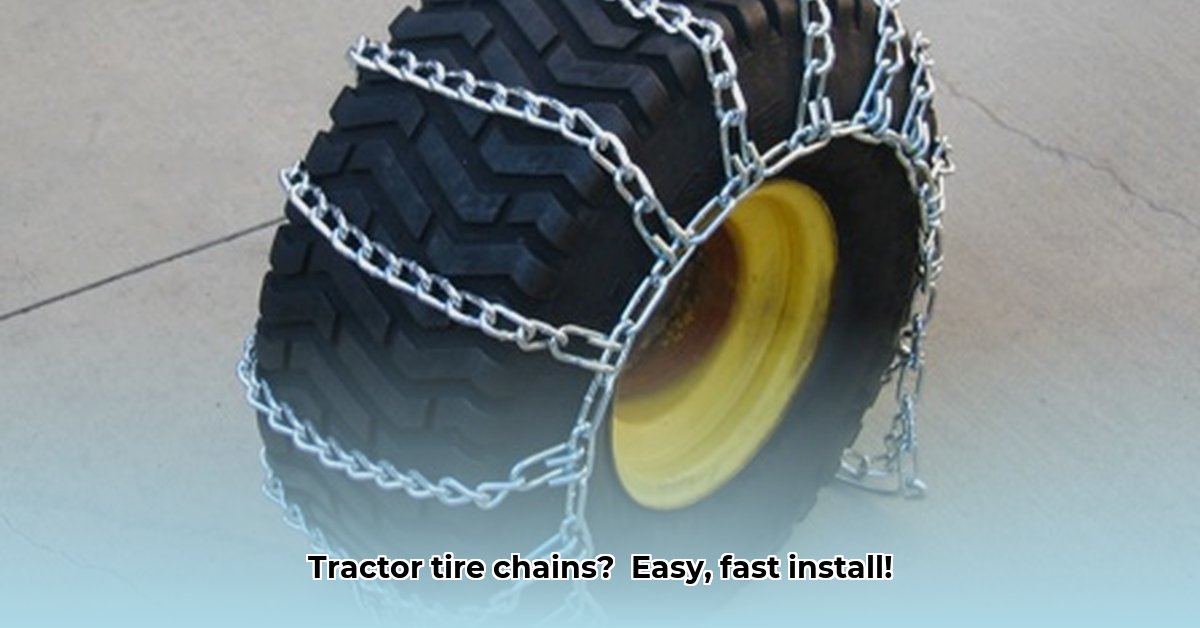
Putting tire chains on your tractor can seem daunting, but with the right technique, it's manageable. This guide details two methods: the traditional method and a faster twine method. We'll compare both, highlighting their pros and cons to help you choose the best approach for your needs and tractor size. Safety is paramount, so we'll emphasize crucial precautions throughout. For more detailed instructions, check out this helpful guide.
How to Put Tire Chains on a Tractor Using the Traditional Method
This tried-and-true method requires some muscle but ensures a secure fit.
Preparation: Gather your chains and ensure they're the correct size for your tractor tires. Double-checking this step before you begin saves time and potential frustration.
Chain Placement: Begin wrapping the chain around the tire, starting at the bottom. Proceed slowly and methodically for a smoother installation. (Note: Work in a well-lit area for better visibility.)
Connecting the Links: Join the chain ends. Most chains have a built-in connector; otherwise, use a sturdy clamp. Ensure the connection is secure to prevent detachment during operation.
Tightening: Evenly tighten the chains around the tire. Aim for a snug fit, avoiding over-tightening which could damage the tire or chains. Check tension frequently and readjust as needed for uniform distribution.
How to Put Tire Chains on a Tractor Using the Twine Method
This innovative method utilizes baling twine to simplify installation, saving you time and effort.
Twine Preparation: Cut several lengths of strong baling twine, long enough to comfortably encircle the tire with extra length. (Tip: Use high-quality twine to avoid breakage.)
Attaching the Twine: Loop the twine around the tire where you'd start with the traditional method. Securely tie one end of the twine to one end of the chain.
Guided Installation: Gently pull the twine around the tire. The twine guides the chain, creating a much smoother and less strenuous installation.
Securing and Final Check: Once the chain is fully around the tire, fasten both ends as in the traditional method. Remove the twine. After this, ensure the chains are snug and evenly distributed.
Comparing the Traditional and Twine Methods: Which is Right for You?
Both methods achieve the same goal, but differ significantly in approach and required effort.
| Method | Advantages | Disadvantages |
|---|---|---|
| Traditional Method | Reliable, requires no additional materials | Physically demanding, time-consuming |
| Twine Method | Easier, faster, less physically strenuous | Requires twine; a slight risk of twine breakage |
Crucial Safety Precautions: Prioritize Safety!
- Stable Ground: Always work on level, stable ground to prevent accidents.
- Careful Handling: Tractor tire chains are heavy—handle them carefully to avoid injuries.
- Appropriate Tension: Ensure chains are snug but not overly tight to prevent tire or chain damage. (Over-tightening can lead to premature chain wear.)
- Regular Inspection: Regularly inspect chains for damage and replace worn or broken components immediately.
- Secure Installation: Never operate your tractor with improperly installed chains.
Have you ever experienced a tire chain mishap? What lessons did you learn? Sharing your experience can help others avoid similar problems.
Choosing the Best Method for Your Tractor
The traditional method proves reliable for those comfortable with manual labor. However, the twine method offers a significant advantage in terms of speed and ease, particularly beneficial when dealing with larger tractors and heavier chains. Ultimately, the best method depends on your comfort level, available tools, and the size of your tractor. But above all, remember that safety always comes first. Take your time, be thorough, and enjoy the satisfaction of a job well done, knowing your tractor is ready for whatever comes its way.